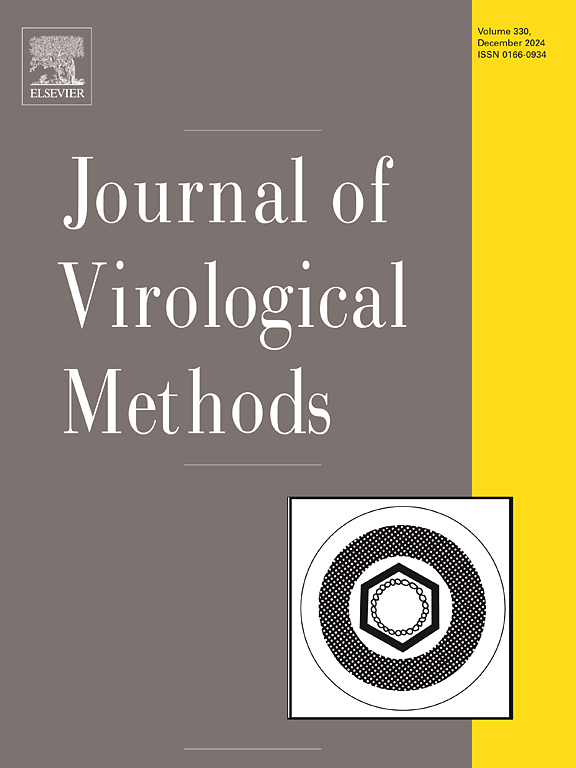寨卡病毒和登革热病毒感染性cDNA克隆、亚基因组复制子及包装系统的构建与应用
IF 1.6
4区 医学
Q3 BIOCHEMICAL RESEARCH METHODS
引用次数: 0
摘要
黄病毒因其迅速传播和可能引起严重临床表现而对全球健康构成重大威胁。了解这些病原体的复制机制并制定有效的抗病毒策略是对抗这些病原体的必要条件。本研究分别获得了寨卡病毒(ZIKV)和登革热病毒(DENV)的全长感染性cDNA克隆。通过转染cDNA克隆质粒成功制备了重组病毒。利用传染性克隆,还生成了ZIKV和DENV亚基因组复制子,它们缺乏prM-E基因,而是表达荧光素酶或荧光标记(OXGFP或mCherry)。这些复制子在BHK-21细胞中表现出高效的复制。利用表达荧光素酶的ZIKV和DENV-2复制子,鉴定出三种潜在的抗病毒药物。这些制剂显示出对DENV-2和ZIKV的活性,而不诱导显著的细胞毒性作用。这证明了这些复制子在筛选抗病毒药物中的重要意义。此外,将包装质粒和复制子共转染到BHK-21细胞中,制备了DENV-2和ZIKV单轮感染颗粒(srip)。包装实验表明,黄病毒可以利用其他物种的prM-E蛋白生成srip。核衣壳(NC)与prM-E蛋白的特异性结合在不同的黄病毒中是不同的。本研究建立的反向遗传学工具将促进DENV-2和ZIKV病毒复制的研究以及针对这两种虫媒病毒的抗病毒药物的开发。本文章由计算机程序翻译,如有差异,请以英文原文为准。
Construction and application of infectious cDNA clone, subgenomic replicon and packaging system for Zika virus and Dengue virus
Flaviviruses pose a significant global health threat due to their rapid spread and potential to cause severe clinical manifestations. Comprehending the mechanisms of replication of these pathogens and developing effective antiviral strategies are essential for combating these pathogens. In the present study, full-length infectious cDNA clones were generated for Zika virus (ZIKV) and Dengue virus (DENV), respectively. Recombinant viruses were successfully produced by transfecting cDNA clone plasmids. Using the infectious clone, ZIKV and DENV subgenomic replicons were also generated, which lack the prM-E gene and instead expressing a luciferase or fluorescent marker (OXGFP or mCherry). The replicons exhibited efficient replication in BHK-21 cells. Through the utilization of ZIKV and DENV-2 replicons that express luciferase, three potential antiviral agents were identified. These agents demonstrated activity against DENV-2 and ZIKV, while not inducing significant cytotoxic effects. This demonstrates the significance of these replicons in the screening of antiviral agents. Moreover, DENV-2 and ZIKV single-round infectious particles (SRIPs) were produced by co-transfecting packaging plasmids and replicons into BHK-21 cells. The packaging assay demonstrated that flaviviruses can utilize the prM-E protein from other species to generate SRIPs. The specific binding of the nucleocapsid (NC) to the prM-E protein varies among different flaviviruses. The reverse genetics tools established in this study will facilitate research on DENV-2 and ZIKV virus replication and the development of antiviral medications targeting these two arboviruses.
求助全文
通过发布文献求助,成功后即可免费获取论文全文。
去求助
来源期刊
CiteScore
5.80
自引率
0.00%
发文量
209
审稿时长
41 days
期刊介绍:
The Journal of Virological Methods focuses on original, high quality research papers that describe novel and comprehensively tested methods which enhance human, animal, plant, bacterial or environmental virology and prions research and discovery.
The methods may include, but not limited to, the study of:
Viral components and morphology-
Virus isolation, propagation and development of viral vectors-
Viral pathogenesis, oncogenesis, vaccines and antivirals-
Virus replication, host-pathogen interactions and responses-
Virus transmission, prevention, control and treatment-
Viral metagenomics and virome-
Virus ecology, adaption and evolution-
Applied virology such as nanotechnology-
Viral diagnosis with novelty and comprehensive evaluation.
We seek articles, systematic reviews, meta-analyses and laboratory protocols that include comprehensive technical details with statistical confirmations that provide validations against current best practice, international standards or quality assurance programs and which advance knowledge in virology leading to improved medical, veterinary or agricultural practices and management.

 求助内容:
求助内容: 应助结果提醒方式:
应助结果提醒方式:


